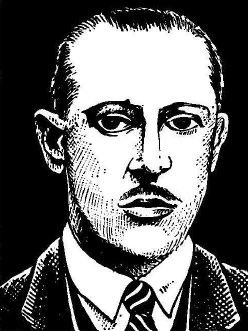
Igor Stravinsky I INTRODUCTION Igor Stravinsky (1882-1971), Russian American composer, one of the most influential figures of music in the 20th century. Igor Fyodorovich Stravinsky was born June 17, 1882, in Oranienbaum (now Lomonosov), the son of a leading bass singer at the imperial opera house in Saint Petersburg. Although a mediocre student, Stravinsky studied law at the University of Saint Petersburg. There he met the son of the Russian composer Nikolay RimskyKorsakov, and his friend's famous father guided Stravinsky's early compositional efforts. II BALLETS AND OTHER EARLY WORKS In 1908 the Russian impresario Sergey Diaghilev, impressed by Stravinsky's orchestral works Scherzo fantastique (1908) and Fireworks (1910), asked the composer to write for his Ballets Russes; thus began an association of many years. His first ballets for Diaghilev, The Firebird (1910) and Petrushka (1911), won immediate success and were greatly admired for their dramatic impact, rich orchestration, and melodies evoking Russian folk song. At the first performance of The Rite of Spring (1913), however, the unconventional choreography and the harsh dissonances and driving, asymmetrical, shifting rhythms of the music prompted a hostile uproar so noisy that the dancers could not hear the orchestra. Later concert performances were well received. The following year, with the outbreak of World War I, Stravinsky settled in Switzerland. There, partly because the difficult social and economic conditions during and after the war made it practically impossible to secure performances for large-scale works, he composed The Soldier's Tale (1918); it calls for limited resources: six instruments and percussion (representing the four sections of the orchestra), three actors, and a dancer. The disillusion of the war years can be seen in this work, as can the impact of jazz, which is also evident in his Rag-time (1918) for 11 instruments and in his Piano Rag-Music (1919). In 1920 Stravinsky moved to Paris. To the years just after this move date the important Symphonies of Wind Instruments (1920), the comic opera Mavra (1922), and the ballet-cantata Les noces (The Wedding), suggested by Russian folk verse and first performed by the Ballets Russes in 1923. Scored for four pianos, percussion, and voices, and influenced by the style of Russian folk melody, Les noces displays a freedom from natural word stresses that became typical of Stravinsky's works. While living in Paris, Stravinsky also began appearing as a pianist and conductor to help support his family. He thus began writing works suitable for his own pianistic ability, such as the Concerto for Piano and Wind Instruments (1924). In the early 1920s he fell in love with the actor Vera de Bosset Soudeikine, whom he married in 1940, after his first wife's death. III NEOCLASSICAL WORKS David Hockney's Set for The Rake's Progress English artist David Hockney designed this elaborate set in 1975 for the Glyndebourne Opera's production of Igor Stravinsky's The Rake's Progress. Hockney often displays a wry sense of humor in his work. Clive Barda/Performing Arts Library After about 1923, Stravinsky's neoclassical works began to appear, characterized by an interest in the forms of the 17th and 18th centuries. The works of this period are also marked by an ideal of objectivity that was in part a reaction against the emotionalism of the late romantic period. This latter ideal was reflected later in his Autobiography (1935), where he wrote that "Music is, by its very nature ... powerless to express anything at all" and declared that performers should follow composers' intentions without adding their own ideas or "self-expression"--an aesthetic position that had a strong impact on the course of modern music. Works from this period include the opera-oratorio Oedipus Rex (1927) and the melodrama Perséphone (1934), as well as the ballet Apollo Musagète (1928, later retitled Apollo), among the earliest of the many Stravinsky works that were written for the Russian-born choreographer George Balanchine. In the mid-1920s Stravinsky underwent a spiritual crisis, and in 1926 he rejoined the Russian Orthodox church (which he had left at the age of 18). Not long afterward, in 1930, he composed his Symphony of Psalms, for chorus and orchestra. Written to a Latin biblical text, this work seemed to represent a temporary disregard of his ideals of strict musical objectivity. In 1939 Stravinsky left Europe for the United States, settling in Hollywood, California. There, he supported himself by commissions. Among diverse works written to order were the Circus Polka (1942), to be danced by circus elephants; Danses concertantes (1942) for orchestra; and Scènes de ballet (1944) for a Broadway revue. More significant works from these years included the Symphony in Three Movements (1945), his Mass (1948), and the highly successful opera The Rake's Progress (1951), a work that can be seen as the summation of his neoclassical period. IV INTEREST IN SERIALISM In 1948 the young American conductor Robert Craft became Stravinsky's friend and musical assistant. Craft encouraged Stravinsky to listen to the music of the serialists, who treated atonal melody as a series of pitches without key-oriented harmonic or melodic relationships, and whose techniques had as a starting point the twelve-tone system of the Austrian composer Arnold Schoenberg. Although Stravinsky had earlier rejected Schoenberg's theories, he became interested in the music of Schoenberg's disciple, the Austrian composer Anton Webern. Gradually Stravinsky drew more and more on serial techniques--integrating them into his own approach, as he had done with every previous musical influence--in works such as the cantata Threni (1958), the Movements for Piano and Orchestra (1959), and his last major work, the Requiem Canticles (1966). In 1967, in his mid-80s and failing in health, Stravinsky conducted a recording of his music for the last time. He died on April 6, 1971, in New York City and was buried in Venice, not far from Diaghilev's grave. During his lifetime, Stravinsky used many musical styles--a coloristic, Russian-influenced style, primitivism, jazz, neoclassicism, bitonality (simultaneous use of two keys), atonality, and serialism. To continue in one path, in his words, was "to go backward." Stravinsky's works both reflected and influenced the most important trends of 20th-century music. Their enduring significance stems from all the technical devices, originality, power, and rationality he brought to them. Contributed By: Ruth Zinar Microsoft ® Encarta ® 2009. © 1993-2008 Microsoft Corporation. All rights reserved.











